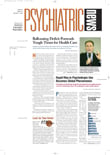For prison psychiatrists, the best suicide-prevention strategies incorporate knowledge of risk factors that extend beyond those found in the general population and the use of specialized tools designed for inmates who pose an imminent suicide risk.
Inmates who receive “Dear John” letters, are detained in secure housing units, or receive a lengthy sentence are among those at increased risk for suicide.
Two forensic psychiatrists, Michael Champion, M.D., and James Knoll IV, M.D., talked about these risk factors and offered suicide-prevention strategies at the annual meeting of the American Academy of Psychiatry and the Law in October.
Champion, who is associate director of forensic psychiatry and an assistant professor of psychiatry at Dartmouth Medical School, noted that suicide is the third-leading cause of death in the correctional environment, behind natural causes and AIDS-related complications. Champion is also the administrative and medical director of the Secure Psychiatric Unit at the New Hampshire Department of Corrections.
He noted that suicide rates differ depending on the type of facility in which inmates are housed. Among prison inmates, the suicide rate is about 1.5 times that of the general population, or 14 per 100,000 inmates. Among jail inmates, Champion said, that rate rises to about nine times that of the general population. People who are newly arrested and brought to lockups, which are holding cells in city or county police or sheriffs' offices, have the highest suicide rate—about 250 times that of the general population.
Knoll explained that prison inmates typically have the lowest suicide rate because, for the most part, “prisons usually have better mental health resources and monitoring ability” than jails.
In addition, he said, people who are sent to prison “have usually been off the streets, and thus off of substances for a long period.”
Jails, which have slightly higher suicide rates, have a transient population, which makes it difficult to follow and monitor people consistently, Knoll said. Often, jails have few mental health resources, and inmates may undergo withdrawal from drugs when first incarcerated.
Suicide rates at lockup facilities are so high, Knoll said, because these facilities “are generally entirely unequipped for suicide monitoring or mental health screening.”
“People admitted to a lockup are fresh off the street,” Knoll continued. Many are intoxicated or withdrawing from substances, he observed, and “experiencing the initial shock and humiliation of arrest and incarceration.”
One of the reasons suicide may be higher among inmates than the general population is the “unending supply of factors that increase stress levels” of inmates, he noted.
Prisons are designed to isolate offenders from society and even from one another. “Separation from family, friends, and other support networks radically increases stress,” Champion said.
Perhaps the most isolative place in prisons is the maximum-security housing unit (SHU), a cell used by prison staff as a disciplinary sanction for inmates who act out in some way.
Inmates typically stay in these environments for 23 hours a day; the remaining hour is for “recreation,” spent in another enclosed space. A number of studies have associated SHU placement with suicide attempts and completed suicides, Champion said.
“This level of isolation can often either generate or exacerbate existing psychiatric symptoms, thus raising suicide risk,” he remarked.
Champion cited data from a 2004 study by Jenny Shaw, M.D., which was published in the March British Journal of Psychiatry. The study found that of 172 suicides committed in British prisons, a third occurred during the first week of incarceration. Half of the suicides occurred upon remand, or being re-sentenced for a parole violation, after release. Seventy-two inmates had a history of mental disorder.
Although suicide risk factors for jail inmates often overlap with those of prison inmates—common risk factors include prior suicide attempts and having a history of a psychiatric disorder—some risk factors are unique to each type of correctional facility.
For instance, Champion noted that suicide risk for jail inmates increases if the inmate is intoxicated upon arrest, experiences recent negative life events such as a spouse's instigating a divorce, other family members' indicating they want no further contact with the prisoner, or receiving new charges while in jail.
Risk factors associated with prison inmates include being housed in an SHU, receiving a long sentence, or being convicted of a violent crime, he said.
Being bullied may also be associated with an elevated risk of suicide for inmates in correctional settings, according to Knoll, director of forensic psychiatry at the New Hampshire department of corrections and an assistant professor of psychiatry at Dartmouth Medical School.
A 2001 study by Eric Blaauw, Ph.D., found that among 95 inmates who committed suicide in Dutch jails between 1987 and 1998, over one-third had been bullied while incarcerated, and 22 percent had reported “serious bullying” by other inmates.
“The authors believe bullying may be a precursor to suicide” for those inmates, he said.
Knoll said he has interviewed a number of suicidal inmates who told him other inmates “held court” on them. In this scenario, an aggressive, “alpha” inmate rounds up other inmates to try“ convicting” a more vulnerable inmate of a real or perceived offense. They then “mete out a punishment” for the inmate, which may include anything from “taking things away from the prisoner to serious physical assault.”
Certain tools—quite literally—are crucial to suicide prevention in correctional settings, Knoll pointed out.
One is the “strong cloth safety smock,” which can be used for inmates who are acutely suicidal.
Anywhere from 80 percent to 90 percent of inmates commit suicide by hanging themselves with bed clothes or sheets, Knoll observed. The smock cannot be torn or ripped to form a noose. Bedding can be made with the same material, he noted.
Another lifesaving resource is a “cutdown” tool, which is a specialized knife built to hook on to cloth and used by prison staff to cut through fibers very quickly to prevent death by suicide but which can't be used by inmates as a weapon.
Knoll noted that “true suicide prevention begins at the point of arrest” and that “police play a critical role in observing and communicating important information about the arrestee's behavior to staff working at lockup facilities, where the risk of suicide is especially high,” he said.
It is also crucial for corrections staff to communicate certain information about inmates to the next shift, he noted, such as a sudden loss of support outside the facility or another negative life event. ▪

